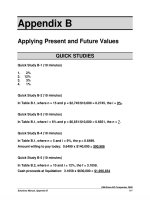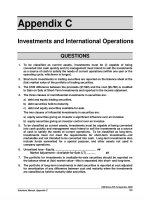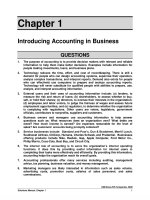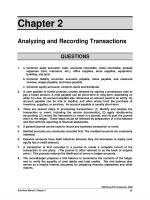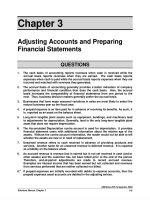Solution manual financial accounting 4e by wild chapter06
Bạn đang xem bản rút gọn của tài liệu. Xem và tải ngay bản đầy đủ của tài liệu tại đây (825.33 KB, 37 trang )
To download more slides, ebook, solutions and test bank, visit
Chapter 6
Reporting and Analyzing Cash and
Internal Controls
QUESTIONS
1.
The seven broad principles are: Establish responsibilities; Maintain adequate records;
Insure assets and bond employees; Separate recordkeeping and custody of assets;
Divide responsibilities for related transactions; Apply technology controls; Perform
regular and independent reviews.
2.
Internal control procedures become especially critical when the manager of a business
can no longer control the business through personal supervision and direct
participation.
3.
Responsibility for related transactions should be divided so that the work of one
department or individual acts as a check on that of another.
4.
Separation of custody from recordkeeping of an asset encourages the asset custodian to
avoid misplacing, misappropriating, or wasting the asset. This arrangement makes
collusion necessary if an asset is to be stolen and the theft concealed in the records.
5.
If individual departments were permitted to deal directly with suppliers, the amount of
merchandise purchased and the resulting liabilities would not be well controlled. Having
individual departments place orders through a purchasing department helps control the
amounts purchased and the resulting liabilities.
6.
The limitations of internal control arise from two sources: the human element (human
error or human fraud) and the cost-benefit principle.
7.
Cash is most liquid; and least liquid is a building. The four assets ordered from most to
least liquid are: cash, accounts receivable, inventory, and building.
8.
A petty cash receipt is a document stating that a payment has been made from petty
cash. The one who received payment and the one who approved payment both sign the
receipt.
9.
Depositing all receipts on the day of receipt (1) creates an independent record of the
amount of cash received and (2) helps prevent an employee from having personal use of
the money for a period of time before depositing it.
10. During the year ended February 26, 2005, cash (and equivalents) of $1,166,000,000 is
used by investing activities. Cash (and equivalents) of $459,000,000 is used by financing
activities.
©McGraw-Hill Companies, 2008
Solutions Manual, Chapter 6
349
To download more slides, ebook, solutions and test bank, visit
11. Circuit City‘s cash at February 28, 2005, equals $879,660,000. It is the second largest
current asset, after Merchandise inventory. Cash comprises about 33% current assets.
Its Cash increased from $783,471,000 at February 29, 2004, to $879,660,000 at February
28, 2005. As a percent of total current assets, its Cash balance increased from about
27% to about 33%
12. Apple‘s cash and equivalents decreased by $427,000,000 during the fiscal year ended
September 25, 2004; from $3,396,000,000 to $2,969,000,000. Its statement of cash flows
identifies several causes for this change. Three major sources and uses are: (1)
$934,000,000 from operating activities; (2) $(1,488,000,000) used by investing activities;
and (3) $127,000,000 provided by financing activities. The largest outflow is the
purchase of short-term investments in the amount of $3,270,000,000.
QUICK STUDIES
Quick Study 6-1 (10 minutes)
1.
The main objective of internal control procedures is to safeguard the
assets of the business. This objective is best accomplished by designing
an operational system with managerial policies that protect the assets
from waste, fraud and theft. The system should be designed in compliance
with the seven broad principles of internal control that are described in
the chapter.
2. Separation of recordkeeping for assets from the custody over assets is
intended to reduce theft and fraud. If this fundamental principle is
followed, there has to be collusion between two or more employees for
assets to be stolen and the theft to be concealed in the records.
3. The responsibility for a transaction should be divided between two or more
individuals or departments to ensure that the work of one acts as a check
on the other. Absent this, someone could create fictitious invoices and
pay the money to herself or himself.
Quick Study 6-2 (10 minutes)
1. A liquid asset refers to an asset that can be readily converted into
another type of asset or be used to satisfy an obligation. A cash
equivalent is a highly liquid short-term investment that can be readily
converted to a known amount of cash and is sufficiently close to its
maturity date so that its market value is relatively insensitive to interest
rate changes.
2. Companies usually invest idle cash in cash equivalents to make a
higher return on these assets.
©McGraw-Hill Companies, 2008
350
Financial Accounting, 4th Edition
To download more slides, ebook, solutions and test bank, visit
Quick Study 6-3 (10 minutes)
1. The cash category includes currency and coins along with the amounts
on deposit in bank accounts, checking accounts, and savings
accounts. Cash also includes items that are acceptable for deposit in
these accounts including customer checks, cashier checks, certified
checks, and money orders.
2. The cash equivalents category includes short-term, highly liquid
investment assets meeting two criteria: (1) readily convertible to a
known cash amount and (2) sufficiently close to their due dates so that
their market value is not sensitive to interest rate changes. Usually
only investments purchased within 3 months of their due date satisfy
these criteria. Examples of cash equivalents include U.S. Treasury bills
and money market funds.
3. Liquidity refers to a company‘s ability to pay for its near-term
obligations.
Quick Study 6-4 (10 minutes)
1. The three basic guidelines for safeguarding cash are:
(a) Separate the duties of those who handle (have custody of) cash from
those that keep cash records.
(b) Require that all cash receipts be deposited daily.
(c) Require that all cash disbursements be made by check.
2. (a) Voucher system of control, and (b) Petty cash system of control.
Quick Study 6-5 (10 minutes)
1. (a) Petty Cash .......................................................... 85.00
Cash .............................................................
85.00
To establish the petty cash fund.
(b) Entertainment Expense ..................................... 52.15
Postage Expense ............................................... 8.95
Printing Expense................................................ 9.10
Cash .............................................................
70.20
To reimburse the petty cash fund.
2. The Petty Cash account is credited when either (1) the dollar amount of
the fund is being reduced, or (2) the fund is being eliminated.
©McGraw-Hill Companies, 2008
Solutions Manual, Chapter 6
351
To download more slides, ebook, solutions and test bank, visit
Quick Study 6-6 (15 minutes)
a.
b.
c.
d.
e.
f.
g.
(i) Book
(i) Book
(i) Book
(i) Bank
(i) Book
(i) Book
(i) Bank
(1)
(ii) Addition
(ii) Subtraction
(ii) Subtraction
(ii) Subtraction
(ii) Addition
(ii) Subtraction
(ii) Addition
(2)
Adjusting entry required
Adjusting entry required
Adjusting entry required
No adjustment required
Adjusting entry required
Adjusting entry required
No adjustment required
Quick Study 6-7 (15 minutes)
Days' sales uncollected =
2008
$85,692
$2,691,855 x 365
11.6 days
Accounts receivable
x 365
Net sales
2007
$80,485
$2,396,858 x 365
12.3 days
Interpretation: The collection of accounts receivable seems to be
slightly improving. It took the company slightly over one-half day less
to collect on its accounts receivable in 2008 than in 2007.
Quick Study 6-8A (10 minutes)
The documents in a voucher system are: Purchase requisition, Purchase
order, Invoice, Receiving report, Invoice approval, and Voucher.
Quick Study 6-9B (15 minutes)
(a) A Discounts Lost account is employed with the Net Method of
recording purchases of inventory.
(b) The advantage of this method is that the Discounts Lost account
highlights for management (on the income statement) the costs
incurred by the business that have resulted from the failure to take
cash discounts. Management can then determine the reason and
possibly correct the handling of future cash payments to ensure that all
favorable purchase discounts are taken.
©McGraw-Hill Companies, 2008
352
Financial Accounting, 4th Edition
To download more slides, ebook, solutions and test bank, visit
EXERCISES
Exercise 6-1 (10 minutes)
Evaluation
The company‘s internal control system failed to require separation of asset
custody from asset recordkeeping.
Principles Ignored
(1) The recordkeeper should not have been allowed to sign the company‘s
checks.
(2) Since a loss was incurred, the company apparently had not bonded its
employee. If it had, the bonding company would have insured the loss.
If regular, independent reviews of the accounting records had been done,
the payments of salary checks to a nonemployee may have been
discovered earlier.
Exercise 6-2 (15 minutes)
(a) Internal Control Problems
(1) A major internal control problem is that the recordkeeper (who has
control over the accounting records) has physical control over the cash
receipts. Nothing in the system prevents the recordkeeper from taking
cash from the mail and using it personally.
(2) The recordkeeper might also delay recording a cash receipt from a
customer until more cash comes in at a later date from a second
customer. Then, the new cash receipt would be deposited and
recorded as a payment made by the first customer. No entry would be
made in the second customer‘s account until cash was received from a
third customer, and so on. (This type of fraud is called "lapping.")
(3) The recordkeeper also could pocket cash and claim that a payment was
never received and apparently lost in the mail.
(b) Internal Control Recommendations
(1) If only one person is present when the mail is opened, that person may
steal cash and claim it was never received. If possible, two people
should be present. Otherwise, the honesty and integrity of the person
chosen to open the mail is critical. One might also consider the use of a
P.O. Box for cash receipts by mail as another control procedure.
(2) It is important the recordkeeper not have physical control over cash.
©McGraw-Hill Companies, 2008
Solutions Manual, Chapter 6
353
To download more slides, ebook, solutions and test bank, visit
Exercise 6-3 (15 minutes)
1.
A cash register (with a locked record) should be used at the sales stand—
it should also be anchored to the stand. If a cash register cannot be used,
the total sales value of the sunscreen, shirts, and sunglasses given to the
employee each day should be calculated. The employee should sign a
receipt for the merchandise and the amount of cash that he or she has
been given. At the end of each day, the employee should be required to
return cash plus remaining sunscreen, shirts, and sunglasses equal to the
amount taken to the stand—possibly consider one or two return trips if
the amounts are large.
2.
The employee should sign a receipt for the total amount of cash he or she
is given each weekend. Each time the employee makes a purchase, he or
she should obtain a signed sales receipt for the payment. The sales
receipt should list the items purchased and the prices paid. When the
employee returns to the store, the total value of the signed sales receipts
plus any remaining cash should equal the amount of cash originally given
to the employee. Also, the merchandise brought back by the employee
should be the same as the items listed on the signed sales receipts.
©McGraw-Hill Companies, 2008
354
Financial Accounting, 4th Edition
To download more slides, ebook, solutions and test bank, visit
Exercise 6-4 (20 minutes)
1.
Jan. 1 Petty Cash ...............................................................
Cash ...................................................................
200
200
To establish a petty cash fund.
2.
Jan. 8 Postage Expense ....................................................
Merchandise Inventory* .........................................
Delivery Expense ....................................................
Miscellaneous Expenses .......................................
Cash ...................................................................
74
29
16
43
162
To reimburse the petty cash fund.
* Transportation-in costs are included in Merchandise
Inventory under a perpetual system.
3.
Jan. 8 Postage Expense ....................................................
Merchandise Inventory ..........................................
Delivery Expense ....................................................
Miscellaneous Expenses .......................................
Cash ...................................................................
74
29
16
43
162
To reimburse the petty cash fund.*
Jan. 8 Petty Cash ...............................................................
Cash ...................................................................
250
250
To increase the petty cash fund.*
* The two January 8 entries can be combined into one entry.
©McGraw-Hill Companies, 2008
Solutions Manual, Chapter 6
355
To download more slides, ebook, solutions and test bank, visit
Exercise 6-5 (20 minutes)
1.
Sept. 9 Petty Cash ...............................................................
Cash ...................................................................
350
350
To establish a $350 petty cash fund.
2.
Sept. 30 Merchandise Inventory* .........................................
Postage Expenses ..................................................
Miscellaneous Expenses .......................................
Cash Short and Over ..............................................
Cash ...................................................................
40
123
80
3
246
To reimburse the petty cash fund.
* Transportation-in costs are included in Merchandise
Inventory under a perpetual system.
3.
Oct. 1
Petty Cash ...............................................................
Cash ...................................................................
50
50
To increase the petty cash fund to $400.
©McGraw-Hill Companies, 2008
356
Financial Accounting, 4th Edition
To download more slides, ebook, solutions and test bank, visit
Exercise 6-6 (20 minutes)
Bank Balance
Add Deduct
Add
1. NSF check from customer returned on Sept.
25 but not recorded by this company.
Book Balance
Not Shown on
Deduct Adjust Reconciliation
x
2. Interest earned on the account.
x
Cr.
Dr.
3. Deposit made on September 5 and
processed by bank on September 6.
4. Check written by another depositor but
charged against this company's account.
x
x
5. Bank service charge.
x
Cr.
6. Checks outstanding on August 31 that
cleared the bank in September.
x
7. Check written against the company account
and cleared by the bank; erroneously not
recorded by the company recordkeeper.
x
8. Principal and interest on a note receivable to
this company is collected by the bank but not
yet recorded by the company.
9. Checks written and mailed to payees on
October 2.
10. Checks written by the company and mailed
to payees on September 30.
11. Deposit made on September 30 after the
bank closed.
12. Special bank charge for collection of note in
No. 8 on company's behalf.
Cr.
x
Dr.
x
Dr.
x
x
x
Cr.
Exercise 6-7 (10 minutes)
1. The voucher system of control establishes procedures for: (a) Verifying,
approving, and recording obligations for eventual cash disbursements,
and (b) Issuing checks for payment of verified, approved, and recorded
obligations.
2. All expenditures should be overseen by a voucher system of control
(not only the purchase of merchandise).
3. The voucher is initially prepared by the accounting department when it
receives the purchase requisition from the department making the
request or when it receives reliable evidence that an obligation has been
incurred.
©McGraw-Hill Companies, 2008
Solutions Manual, Chapter 6
357
To download more slides, ebook, solutions and test bank, visit
Exercise 6-8 (25 minutes)
DEL GATO CLINIC
Bank Reconciliation
June 30, 2008
Bank statement balance ........
Add
Deposit of June 30 ................
Deduct
Outstanding checks.............
Adjusted bank balance ..........
$10,555
2,856
13,411
1,829
$11,582
Book balance.................................................................................
$11,589
Add
Error on Ck. No. 919..................................................................
9
11,598
Deduct
Bank service charge.................................................................
16
Adjusted book balance ..............................................................
$11,582
Exercise 6-9 (10 minutes)
June 30 Cash ....................................................................
Utilities Expense ..........................................
9
9
To correct a journal entry error.
30 Miscellaneous Expenses ..................................
Cash ..............................................................
16
16
To record bank service charge.
Exercise 6-10 (15 minutes)
(a) Days' sales uncollected on December 31, 2007:
$61,000
$665,000
x 365 = 33.5 days
Days' sales uncollected on December 31, 2008:
$93,000
$747,000
x 365 = 45.4 days
(b) Evaluation: The change from 33.5 to 45.4 days' sales uncollected
indicates that the receivables have become less liquid. While the
accounts receivable were, on average, collected in about one month at
the end of 2007, this has increased by about 12 days in Year 2008. The
company needs to follow up to identify the reasons for this change.
©McGraw-Hill Companies, 2008
358
Financial Accounting, 4th Edition
To download more slides, ebook, solutions and test bank, visit
Exercise 6-11A (10 minutes)
1.
E
3.
A
5.
D
2.
C
4.
F
6.
B
Exercise 6-12B (25 minutes)
a.
Recording inventory at gross amounts
Oct. 2 Merchandise Inventory ................................................ 3,000
Accounts Payable ..................................................
3,000
To record merchandise purchases.
10 Accounts Payable ........................................................ 500
Merchandise Inventory .........................................
500
To record credit memo for returns.
17 Merchandise Inventory ................................................ 5,400
Accounts Payable ..................................................
5,400
To record merchandise purchases.
26 Accounts Payable ........................................................ 5,400
Merchandise Inventory* ........................................
Cash ........................................................................
108
5,292
To record payment for merchandise less the
discount. *($5,400 x .02)
31 Accounts Payable ........................................................ 2,500
Cash ........................................................................
2,500
To record payment for merchandise less the returns
($3,000 - $500).
©McGraw-Hill Companies, 2008
Solutions Manual, Chapter 6
359
To download more slides, ebook, solutions and test bank, visit
Exercise 6-12B (Concluded)
b.
Recording inventory at net amounts
Oct. 2 Merchandise Inventory ................................................ 2,940
Accounts Payable ..................................................
2,940
To record merchandise purchases less
discount [$3,000 - ($3,000 x .02) = $2,940].
10 Accounts Payable ........................................................ 490
Merchandise Inventory ..........................................
490
To record credit memo for returns
[$500 - ($500 x .02)].
*13 Discounts Lost .............................................................
Accounts Payable ..................................................
50
50
To record the discount lost [($3,000 - $500) x.02].
17 Merchandise Inventory ................................................ 5,292
Accounts Payable ..................................................
5,292
To record merchandise purchases less
discount [$5,400 - ($5,400 x .02) = $5,292].
26 Accounts Payable ........................................................ 5,292
Cash ........................................................................
5,292
To record payment for merchandise.
31 Accounts Payable ........................................................ 2,500
Cash ........................................................................
2,500
To record payment for merchandise less returns
($2,940 - $490 + $50).
* This entry could alternatively be recorded on October 31 when the cash payment is
made (this is likely since the invoice was filed incorrectly).
©McGraw-Hill Companies, 2008
360
Financial Accounting, 4th Edition
To download more slides, ebook, solutions and test bank, visit
PROBLEM SET A
Problem 6-1A (20 minutes)
1. Violates separation of duties. The company should implement a policy
whereby the person recording incoming cash receipts is not responsible
for posting the payments to the customer accounts.
2. Violates the principle of establishing responsibility. Only Julia should
have access to the petty cash fund since she is the custodian. The
company should implement a policy of not allowing petty cash
transactions over the lunch hour. Alternatively, Justine could also serve
as a petty cash custodian with his own petty cash fund.
3. Violates the proper application of technological controls. While the
daily backup is a very good internal control, the tape needs to be taken
off the premises every night.
If the building and computer are
destroyed, the data then can be restored from the tape since it is safely
kept off the premises. The company should implement a policy of
storing tapes off the premises nightly.
4. Violates regular and independent review. Benedict Shales needs to
implement a way to regularly and independently review his employees.
Hiring of internal auditors or an outside consultant to objectively review
the internal controls and the employees‘ work needs to be implemented.
5. Violates the insuring of assets and the bonding of key employees. We
do not have enough information to know if the company can afford the
move to the higher deductible on the property insurance. However, we
can say that dropping the insurance for bonding the employees
weakens internal control. If the company does need to engage in cost
cutting they should do it without compromising its internal controls.
The insurance for the bonding of employees (or at least key employees
and those in sensitive positions) should be reinstated.
©McGraw-Hill Companies, 2008
Solutions Manual, Chapter 6
361
To download more slides, ebook, solutions and test bank, visit
Problem 6-2A (30 minutes)
Part 1
Feb. 2 Petty Cash .................................................................... 400
Cash ........................................................................
400
To establish the $400 petty cash fund.
Part 2
Nakashima Gallery
Petty Cash Payments Report (for February)
Delivery expense
Feb. 23 Delivery of customer's merchandise .........................
$ 20.00
Mileage expense
Feb. 14 Reimbursement for mileage ........................................
68.00
Postage expense
Feb. 12 Express delivery of contract .......................................
$ 7.95
Feb. 27 Purchased postage stamps ........................................
54.00
61.95
Merchandise inventory (transportation-in)*
Feb. 9 COD charges on purchases ........................................
32.50
Feb. 25 COD charges on purchases ........................................
13.10
45.60
Office supplies expense
Feb. 5 Purchased paper for copier ........................................
14.15
Feb. 20 Purchased stationery...................................................
67.77
Total
81.92
$277.47
* Transportation-in costs are included in Merchandise Inventory under a perpetual system.
Part 3
Feb. 28 Delivery Expense .........................................................20.00
Mileage Expense ..........................................................68.00
Postage Expense .........................................................61.95
Merchandise Inventory ................................................45.60
Office Supplies Expense .............................................81.92
Cash Over and Short ................................................... 2.11
Cash ........................................................................
279.58
To reimburse the petty cash fund.
Feb. 28 Petty Cash ....................................................................
100.00
Cash ........................................................................
100.00
To increase the petty cash fund to $500.
Note: The two Feb. 28 entries can be combined into one.
©McGraw-Hill Companies, 2008
362
Financial Accounting, 4th Edition
To download more slides, ebook, solutions and test bank, visit
Problem 6-3A (20 minutes)
Part 1
May 1 Petty Cash ....................................................................300.00
Cash ........................................................................
300.00
To establish the $300 petty cash fund.
May 15 Janitorial Expenses .....................................................
Miscellaneous Expenses ............................................
Postage Expenses .......................................................
Advertising Expense ...................................................
Cash Over and Short .............................................
Cash ........................................................................
88.00
53.68
53.50
47.15
4.48
237.85
To reimburse the petty cash fund.
May 16 Petty Cash ....................................................................200.00
Cash ........................................................................
200.00
To increase the petty cash fund to $500.
Note: The May 31 entries can be combined into one entry.
May 31 Postage Expenses .......................................................147.36
Mileage Expense .......................................................... 23.50
Delivery Expense ......................................................... 34.75
Cash Over and Short ................................................... 6.19
Cash ........................................................................
211.80
To reimburse the petty cash fund.
May 31 Cash ..............................................................................100.00
Petty Cash ..............................................................
100.00
To decrease the petty cash fund to $400.
Part 2
If the May 31 replenishment is not made and no entry is recorded, then
several expenses would not be recognized and both net income and equity
would be overstated by $211.80 ($147.36 + $23.50 + $34.75 + $6.19). Also,
the petty cash asset and total assets would be overstated by $211.80.
©McGraw-Hill Companies, 2008
Solutions Manual, Chapter 6
363
To download more slides, ebook, solutions and test bank, visit
Problem 6-4A (30 minutes)
Part 1
BRANCH COMPANY
Bank Reconciliation
July 31, 2008
Bank statement balance ............
Add
Deposit of July 31.....................
$27,233
11,514
38,747
Book balance...................................................................................
$27,497
Add
Proceeds of note less
Deduct
collection charge......................................................................
7,955
35,452
Deduct
Checks No. 3031...... $1,482
3065......
382
3069...... 2,281
Adjusted bank balance ..............
NSF check ...................... $ 805
Service charge ............... 25
Error (Check 3056)........ 20
850
Adjusted book balance................................................................
$34,602
4,145
$34,602
Part 2
July 31 Cash .............................................................................. 7,955
Collection Expense .....................................................
45
Notes Receivable ...................................................
8,000
To record note collection less fees.
July 31 Accounts Receivable—E. Shaw .................................
Cash ........................................................................
805
805
To charge account for NSF check plus fees.
July 31 Miscellaneous Expenses ............................................
Cash ........................................................................
25
25
To record bank service fee.
July 31 Rent Expense ...............................................................
Cash ........................................................................
20
20
To correct an entry error.
©McGraw-Hill Companies, 2008
364
Financial Accounting, 4th Edition
To download more slides, ebook, solutions and test bank, visit
Problem 6-4A (Concluded)
Part 3
a.
If the company's Cash account balance of $27,497 is listed on the
bank reconciliation as $27,947 then:
(i)
The final balance that results from adjusting the bank statement
balance will not be affected by the error; and
(ii) The final balance that results from adjusting the book balance of
cash will be overstated by $450 ($27,947 - $27,497), and the bank
reconciliation will not balance.
b. The bank's collection of the $8,000 note less the $45 collection fee
should have been added to the book balance of cash. Instead, it was
added to the bank statement balance. As a result:
(i)
The final balance that results from adjusting the bank statement
balance will be overstated by $7,955; and
(ii) The final balance that results from adjusting the book balance
will be understated by $7,955.
©McGraw-Hill Companies, 2008
Solutions Manual, Chapter 6
365
To download more slides, ebook, solutions and test bank, visit
Problem 6-5A (50 minutes)
Part 1
CHAVEZ COMPANY
Bank Reconciliation
September 30, 2008
Bank statement balance...............
Add
$18,453.25
Deposit of Sept. 30.......................
1,682.75
20,136.00
Deduct
Checks No. 5893 .......$494.25
5906 ......... 982.30
5908 ....... 388.00
Adjusted bank balance.................
1,864.55
$18,271.45
Book balance.............................................................................
$17,404.20
Add
Interest earned...... $ 12.50
Proceeds of note
less $15 fee .........1,485.00
1,497.50
18,901.70
Deduct
NSF check.................. 600.25
Error (Check 5904) .. 30.00
630.25
Adjusted book balance .......... $18,271.45
326.45
Part 2
Sept. 30
Cash ..............................................................................
12.50
Interest Earned .......................................................
12.50
To record interest earned.
30
Cash ..............................................................................
1,485
Collection Expense ......................................................15
Notes Receivable ...................................................
1,500
To record note collection less fee.
30
Accounts Receivable— S.Nilson ................................
600.25
Cash ........................................................................
600.25
To charge account for NSF check plus fee.
30
Computer Equipment...................................................30
Cash ........................................................................
30
To correct an entry error.
©McGraw-Hill Companies, 2008
366
Financial Accounting, 4th Edition
To download more slides, ebook, solutions and test bank, visit
Problem 6-5A (Concluded)
Part 3
There are several possible reasons why some prenumbered checks are
missing from the sequence of canceled checks returned with a bank
statement. Reasons include:
(1) Some of the checks in the numbered sequence may have cleared the
bank in a previous period and were returned with the bank statement
in that previous period.
(2) Some of the checks in the numbered sequence may remain
outstanding. If so, they will be returned with the bank statement in a
later period when they clear the bank.
(3) The issuer of the checks may have voided one or more of the checks
in the numbered sequence, perhaps because of making an error in
writing the checks.
(4) Occasionally, a check will reach the bank but the bank will incorrectly
charge the check to the wrong account. When the bank detects the
error, it will return the check separately with a note of explanation to
the depositor.
©McGraw-Hill Companies, 2008
Solutions Manual, Chapter 6
367
To download more slides, ebook, solutions and test bank, visit
PROBLEM SET B
Problem 6-1B (20 minutes)
1. Violates both applying technological control and effective segregation
of duties. It is safe to assume that Latisha Tally has knowledge of
employee passwords since she implemented the system of password
protection companywide. It is a potentially insecure situation that
Latisha processes payroll and can now probably change employee pay
rates at will, or add a fictitious employee to the file. The company
should hire an outside consultant to rework the password protection
system so Latisha will not have the knowledge that she currently
possesses.
2. Violates applying technological controls. The theater‘s system needs to
be backed up at least daily, not weekly. The theater needs to change the
backup policy and make sure the backup copies are stored off premises.
3. Violates segregation of duties. The company needs to have three
employees handle these functions instead of two. One employee should
place purchase orders, one should receive merchandise, and the third
should pay vendors.
4. Violates applying technological controls. The use of the check protector
is a good internal control. However the company needs to keep the
checks and check protector in a locked environment to prevent
unauthorized use.
5. Violates segregation of duties. It is good internal control to separate
duties for cash receipts and cash disbursements.
Moreover, an
employee independent of these two functions should be given the
responsibility for reconciling the bank account monthly.
If no
employees are available, this is an acceptable duty for the owner as it
allows for owner oversight, which is good internal control.
©McGraw-Hill Companies, 2008
368
Financial Accounting, 4th Edition
To download more slides, ebook, solutions and test bank, visit
Problem 6-2B (30 minutes)
Part 1
Mar. 5 Petty Cash .................................................................... 250
Cash ........................................................................
250
To establish the $250 petty cash fund.
Part 2
Hill Street Music Center
Petty Cash Payments Report (for March)
Delivery expense
Mar. 11 Delivery of customer's merchandise ..........................
$ 10.75
Mileage expense
Mar. 30 Reimbursement for mileage ........................................
56.80
Postage expense
Mar. 28 Paid postage .................................................................
18.00
Merchandise inventory (transportation-in)*
Mar. 6 COD charges on purchases ........................................
$12.50
Mar. 27 COD charges on purchases ........................................
45.10
57.60
Office supplies expense
Mar. 12 Purchased file folders ..................................................
14.13
Mar. 14 Reimbursement for office supplies ............................
11.65
Mar. 18 Purchased paper ..........................................................
20.54
Total
46.32
$189.47
* Transportation-in costs are included in Merchandise Inventory under a perpetual system.
Part 3
Mar. 31 Delivery Expense .........................................................
10.75
Mileage Expense ..........................................................
56.80
Postage Expense .........................................................
18.00
Merchandise Inventory ...............................................
57.60
Office Supplies Expense .............................................
46.32
Cash Over and Short .............................................
Cash ........................................................................
1.00
188.47
To reimburse the petty cash fund.
Mar. 31 Petty Cash ....................................................................
50.00
Cash ........................................................................
50.00
To increase the petty cash fund to $300.
Note: The two entries on Mar. 31 could be combined into one.
©McGraw-Hill Companies, 2008
Solutions Manual, Chapter 6
369
To download more slides, ebook, solutions and test bank, visit
Problem 6-3B (20 minutes)
Part 1
Jan. 3 Petty Cash ....................................................................150.00
Cash ........................................................................
150.00
To establish the petty cash fund.
Jan. 14 Office Supplies Expense .............................................
Merchandise Inventory* ..............................................
Repairs Expense—Computer .....................................
Miscellaneous Expenses ............................................
Cash Over and Short ...................................................
Cash ........................................................................
14.29
19.60
38.57
12.82
2.44
87.72
To reimburse the petty cash fund.
* Transportation-in costs are included in Merchandise Inventory
under a perpetual system.
Jan. 15 Petty Cash .................................................................... 50.00
Cash ........................................................................
50.00
To increase the petty cash fund.
Note: The Jan. 31 entries can be combined into one entry.
Jan. 31 Advertising Expense ................................................... 50.00
Postage Expenses ....................................................... 48.19
Delivery Expense ......................................................... 78.00
Cash Over and Short ................................................... 6.46
Cash ........................................................................
182.65
To reimburse the petty cash fund.
Jan. 31 Petty Cash .................................................................... 50.00
Cash ........................................................................
50.00
To increase the petty cash fund.
Part 2
If the January 31 reimbursement is not made and no entry is recorded, then
the expenses would not be recognized and both net income and equity
would be overstated by $182.65 ($50.00 + $48.19 + $78.00 + $6.46). Also,
the petty cash asset and total assets would be overstated by $182.65.
©McGraw-Hill Companies, 2008
370
Financial Accounting, 4th Edition
To download more slides, ebook, solutions and test bank, visit
Problem 6-4B (30 minutes)
Part 1
SEVERINO CO.
Bank Reconciliation
December 31, 2008
Bank statement balance ..............
Add
Deposit of Dec. 31 .......................
Deduct
Checks No. 1242 ..... $ 410.40
1273 ..... 4,589.30
1282 ..... 400.00
Adjusted bank balance.................
$46,822.40 Book balance .................................................................................
$32,878.30
Add
9,583.10 Error (Ck 1267) .... $
9.00
56,405.50 Proceeds of note
less $20 fee........ 18,980.00
18,989.00
51,867.30
Deduct
NSF check............ $ 762.50
Printing fee ...........
99.00
5,399.70
861.50
$51,005.80 Adjusted book balance...............................................................
$51,005.80
Part 2
Dec. 31 Cash ............................................................................... 9
Office Supplies .......................................................
9
To correct an entry error.
31 Cash ...............................................................................
18,980
Collection Expense ...................................................... 20
Notes Receivable....................................................
19,000
To record note collection less fees.
31 Accounts Receivable—Titus Industries .....................
762.50
Cash .........................................................................
762.50
To charge account for NSF check plus fees.
31 Miscellaneous Expenses ............................................. 99
Cash .........................................................................
99
To record check printing charge.
Part 3
In a banking context, a debit memo is notification from the bank that it has
debited the depositor's account. Since the depositor's account is a liability of the
bank (a credit balance account), the debit notification means the bank has
reduced the depositor's account balance. Conversely, a credit memo is a
notification that the depositor's account has been credited, which means the
bank has increased the depositor‘s cash balance.
©McGraw-Hill Companies, 2008
Solutions Manual, Chapter 6
371
To download more slides, ebook, solutions and test bank, visit
Problem 6-5B (50 minutes)
Part 1
SHAMARA SYSTEMS
Bank Reconciliation
May 31, 2008
Bank statement balance .................
Add
Deposit of May 31...........................
$21,762.70 Book balance .............................................................................
$15,177.30
Add
2,727.30
Proceeds of note less
24,490.00
$50 fee .....................................................................................
7,350.00
22,527.30
Deduct
Deduct
Checks No. 1780......$1,425.90
1786...... 353.10
1789...... 639.50
Adjusted bank balance....................
NSF check...........$431.80
Service charge...... 14.00
2,418.50 Error (Ck 1788)...... 10.00
455.80
$22,071.50 Adjusted book balance ...........................................................
$22,071.50
Part 2
May 31 Cash ..............................................................................
7,350
Collection Expense ..................................................... 50
Notes Receivable ...................................................
7,400
To record note collection less fee.
31 Accounts Receivable—W. Sox ...................................
431.80
Cash ........................................................................
431.80
To charge account for NSF check plus fee.
31 Miscellaneous Expenses ............................................ 14
Cash ........................................................................
14
To record bank service fee.
31 Utilities Expense .......................................................... 10
Cash ........................................................................
10
To correct an entry error.
©McGraw-Hill Companies, 2008
372
Financial Accounting, 4th Edition
To download more slides, ebook, solutions and test bank, visit
Problem 6-5B (Concluded)
Part 3
There are several possible reasons why some prenumbered checks are
missing from the sequence of canceled checks returned with a bank
statement. Reasons include:
(1) Some of the checks in the numbered sequence may have cleared the
bank in a previous period and were returned with the bank statement
in that previous period.
(2) Some of the checks in the numbered sequence may remain
outstanding. If so, they will be returned with the bank statement in a
later period when they clear the bank.
(3) The issuer of the checks may have voided one or more of the checks
in the numbered sequence, perhaps because of making an error in
writing the checks.
(4) Occasionally, a check will reach the bank but the bank will incorrectly
charge the check to the wrong account. When the bank detects the
error, it will return the check separately with a note of explanation to
the depositor.
©McGraw-Hill Companies, 2008
Solutions Manual, Chapter 6
373




